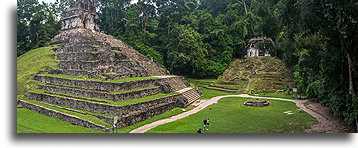

This is one of the best examples of architecture and bas-relief carvings that the Maya produced. Palenque flourished in the 7th century. After AD 810 the ruler and the elite disappear from the city and construction of the ceremonial center suddenly stopped. A few generations later people completely abandoned this city and it was taken by the rain forest. Palenque archeological site today is probably only a small part of the ancient city. Archeologists estimate that another 80-90% of the city is still covered by with greenery deep in the surrounding forest.





In Palenque, you can see the pre-Columbian palace. It is not difficult to realize that Maya mastered the use of the Corbel arch construction method, the technique of joining stone blocks to create a false arch. With this skill, they could raise stone covered buildings with rooms. However, Corbel vaults based on the same technique require a large number of masonry blocks. The whole construction of all buildings is very heavy and limits the width of the rooms. Therefore, the rooms and corridors are always narrow and have very high vaults.




The palace in Palenque is a complex of interconnected buildings with internal courtyards. The most unusual is the four-story tower. This type of building is hard to find in other Maya cities. The palace was home of the local aristocracy and served many functions. One of the courtyards for example was used to receive guests, and present prisoners of war. The stone reliefs feature captives with tied hands waiting to be sacrificed. The palace also had a bath and toilets. Water was supplied from a nearby stream by a stone aqueduct. The duct system drained rainwater. The whole structure is the result of many building changes made over a period of 400 years.



Temple of the Inscriptions is a pyramidal structure that holds glyphic text, which records many years of the city’s history. The temple has also a stone duct that aligns with the Sun at the winter solstice. This hidden feature of the building was used for special purposes. We were told a story describing the way in which ruler introduced his son. From the top of the pyramid, the royal child was first presented to a large group of subordinates gathered below. Exactly at the moment when sunrays illuminated a stone channel, reaching the dark chamber and the boy held there, he was shown to the people. The warm orange spotlight on the naked baby’s body must have looked like a flash of gold. Such ceremony was to indicate the divine origin of the future ruler. Unfortunately, temple is closed to public; we could only adore it from the distance.



Near the small waterfalls there is, usually overlooked by visitors, a group of residential buildings. Originally, houses had stone roofs. There was a steam room in one of the buildings. Hot stones were placed there, which were sprinkled with water to generate heat and humidity. To cleanse the body, mineral and aromatic oils were also used.







